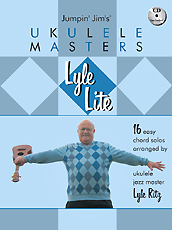
We recently picked up a copy of the latest book in the Jumpin' Jim Ukulele Masters series, Lyle Lite, and have been noodling around with it for a while.
This is the third book/CD combo by Lyle in the series, and the second book to feature chord solos exclusively. If you're already familiar with Lyle's stuff, get the book. You'll find a whole slew of wonderful additions to your repertoire:
- Avalon
- Bb Blues In C
- Beautiful Dreamer
- Brahms' Lullaby
- Bye Bye Blackbird
- Edelweiss
- Harbor Lights
- Home On The Range
- Let Me Call You Sweetheart
- My Melancholy Baby
- On The Beach At Waikiki
- Ramblin' Rose
- Sabor A Mi (Be True To Me)
- Shine On Harvest Moon
- Surfer Girl
- Where You Look (That's Where I'll Be)
First, chord solos are arrangements in which the melody is played via the chord changes. You essentially play a new chord for each note in the melody. Depending on the tune and the arrangement, this can be pretty tricky stuff. You need to be comfortable playing all the way up the ukulele fretboard in order to complete the melodies. If this is all new to you, we recommend starting out with the arrangement of "Ain't She Sweet" featured in Jumpin' Jim's Ukulele Gems. It's the arrangement that made the whole chord solo thing "click" for us.
Chord soloing is not impossible (stick with it!), and is really the thing that will take your uke playing to the next level. While the arrangements in Lyle Lite are intended to be "easy" chord solos, we have a few caveats. First, with Lyle's arrangements, "easy" is a relative term. These are definitely way easier than the chord solos in Jumpin' Jim's Ukulele Masters: Lyle Ritz Solos. But chord solo newbies will still find them pretty daunting. The included CD will help you a lot. But on the CD, Lyle is playing a uke with "Low G" tuning (which will be unfamilar to most beginners). Players with conventionally tuned ukes will find that the arrangements will sound different from Lyle's performance (but still swell!)
Probably the biggest caveat for beginning uklele players is that Lyle's arranements require a fretboard with more than 12 frets. (This was our biggest frustration with the first Lyle Ritz Solos book: we were all charged up, ready for the challenge, and found that we didn't have enough frets.) To master the the chord solos in Lyle Lite, you'll need a uke with a longer fretboard (such as a concert scale ukulele or tenor ukulele, which is what Lyle plays). Clarification: Nina astutely notes that not all concert or tenor ukes will have enough frets. Be sure to look for ones that have 14 frets to the body. (Thanks, Nina!)
Finally, a tip for beginners that's missing from the book's instructions and chord diagrams: many times you'll see a pattern that appears to require a succession of different chord fingerings but which you can actually play from one spot on the fretboard. Here's an example: you might need to go from 1324 to 1322. Freakishly hard, if you try fingering each chord with all four fingers. But set up the 1322 first by laying your index finger across all four strings at the first fret; then lay down your middle finger down on the top two strings to make the "22" part, and your place your ring finger on the third string to complete the chord. Surprise! Your pinkie is now free to hit the 4th fret to change this pattern from 1322 to 1324! Sounds tricky, but it's sooper simple once you know the secret!
Link

3 comments:
"To master the the chord solos in Lyle Lite, you'll need a uke with a longer fretboard (such as a concert scale ukulele or tenor ukulele, which is what Lyle plays)."
Well, but there are plenty of concert and tenor ukes that are only 12 frets to the body. What you really need is a 14 fret to the body concert or tenor ukulele.
...also there are supersopranos (14 fret to the body concert-scale necks on soprano ukes)...these will also work fine. The key is the 14 fret to the body thing, no matter what the body size.
Good clarification. I'll update it, Nina!
Gp
Post a Comment